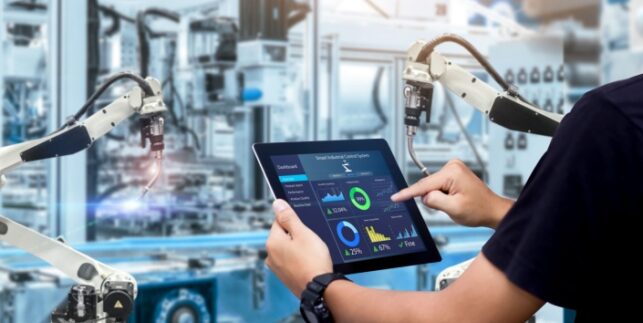Predictive Analytics in Manufacturing Use Cases & Benefits

Manufacturing can be chaotic. From unexpected machine breakdowns to materials that suddenly cost more than budgeted for, it’s easy for production to be impacted by unexpected events.
But what if you could anticipate what was going to happen before it occurred?
Predictive analytics and Real-time Operational Intelligence (RtOI) solutions enable manufacturers to stay on top of all factory needs through the use of machine learning (ML) and artificial intelligence (AI), providing them with insight into potential events before they impact production.
How It Works
Predictive analytics compares historical behavior with the current production output and applies artificial intelligence and advanced algorithms to the data, transforming it to meaningful insight into the state of the factory floor. Manufacturers can then use the actionable tips to make insight-backed decisions in real-time.
Today, manufacturers have to pull data from multiple sources, including:
- Machines.
- ERPs.
- CRMs.
- Human resource solutions.
- Additional cameras, sensors, and more.
This creates a tremendous amount of digital data that manual resources alone cannot effectively manage. To gain relevant insight, manufacturers need to fuse together the information and apply advanced AI algorithms. This can only be done through the integration of an RtOI solutions
Benefits of Predictive Analytics
Integrating predictive analytics tools for manufacturing improves visibility and makes it easier for key stakeholders to understand what is going on in their factory in real-time, enabling them to rapidly adapt when necessary.
Creates a Single Source of Truth
With only subjective accounts and manually collected data to go on, it can be difficult to determine the exact course of events on the factory floor. Using RtOI with predictive analytics standardizes objectives for all production-related information. Key stakeholders can access the data, focusing on their specific needs, and immediately understand the true state of the factory in real-time. This reduces the amount of time your staff must spend tracking down data and questioning coworkers when something goes wrong, improving responsiveness and cross-team communication when it matters most.
Helps Reach Business Goals
Manufacturing is a growth-heavy industry, and production efficiency is key to achieving that growth. Making the most of every resource enhances quality and reduces costs, strengthening competitive advantage. Predictive software solutions identify actionable ways to improve KPIs and maximize profit margin, helping manufacturers effectively manage operations and retain growth levels.
Maintains Data Accuracy and Consistency
Relying on human input to record data is a shaky strategy at best. Human operators can get tired, are prone to typos, and have many other things on their minds when working on the line. They often make mistakes during their data entry duties, even when putting forth their best efforts. Powerful RtOI solutions designed for manufacturers can reduce human error by automatically tracking production, material use, machine downtime, and more. The ideal RtOI solution will enable the intertwinement of human intelligence into the production workflow while ensuring accuracy and reducing errors, creating the best possible scenario.
Centralizes and Safeguards Data
Factories today often use several different software solutions at once, including ERP, CMS, and more. Storing information in so many different places creates thousands of data points that must be sifted through when looking for answers.
RtOI solutions aggregate information from multiple sources and centralizes it into one easy-to-use manufacturing solution. Data is then fused together using advanced algorithms and AI, making it easier to extract the right data when it is needed most. RtOI solutions that are cloud-based ensure that access to information is always secure.
Predictive Analytics Use Cases in Manufacturing
Digitalization and integration of Real-time Operational Intelligence (RtOI) solutions have transformed the manufacturing industry by enhancing stakeholders’ visibility and control over the production process. Manufacturing plants that have adapted their workflows and integrated technology to their shop floor have seen increased productivity, enhanced operational and machine efficiency levels, reduced downtimes, and an overall increase in OEE.
Operational Improvement
Many factories show considerable room for improvement in their OEE score. However, it is often difficult to pinpoint in real-time what has a direct negative impact on the overall OEE. Something as simple and routine as a shift change could cause a significant loss in production, yet without predictive intelligence and RtOI, it would be difficult to identify.
Predictive analytics and manufacturing optimization solutions can identify these common productivity issues in real-time, shortening response time and ensuring enhanced productivity. For instance, manufacturing software solutions can trigger alerts for productivity downslide after each shift and suggest introducing a slightly larger overlap in shifts to compensate. Similar improvements can be made in all areas of plant operations, including staffing, logistics, and quality control.
Proactive Maintenance
Machinery breakdown is a leading cause of manufacturing downtime, costing plants hundreds of thousands (or even millions) of dollars per year. Preventative maintenance can significantly reduce machine breakdowns, but only if it is done on a regular basis and well before problems begin to occur. This has always proved challenging for manufacturers, and an estimated 70% of facilities do not know when their equipment is due for maintenance or an upgrade.
Predictive technology tracks machine performance and other indicators that suggest a particular machine may break down soon and prompts managers to have that machine inspected and serviced as soon as possible. These directions provide the foundations for a proactive maintenance strategy that maximizes machine uptime and plant profitability.
Materials Management
Maintaining a healthy profit margin in manufacturing requires paying careful attention to the cost of raw materials and machine parts. With manufacturing data analytics and real-time machine monitoring, you will know when it is most cost-effective to replenish your stock of each material. The software makes these recommendations based on both current prices and historical costs to optimize your purchasing process. Predictive quality analytics can also help minimize waste by lowering scrap rates and other key metrics.

Changing the way people work in factories
Request a DemoHarness the Power of Predictive Analytics in Manufacturing
Predictive software is a game-changing technology for manufacturers in every industry. Whether operating a plastic manufacturing plant, the automotive industry, food and beverage, or any other type of manufacturing, predictive analytics and RtOI can instantly digitalize your entire shop floor.
The Matics RtOI solution can aggregate data from multiple sources ranging from ERP’s and MRP’s individual machines and even human counterparts. Matics brings together all available data, fuses it together, and applies AI and ML to yield actionable insights that can be used to optimize operations in real-time. Matics software uses both historical and real-time data to provide real-time insights into the state of your factory floor, streamlining production and operations at every step of the way.
Contact us today to learn how Matics can enhance your productivity, reduce downtime, increase OEE and transform your manufacturing floor.




